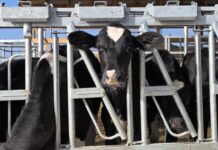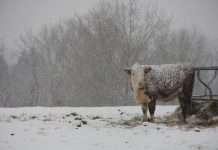Early summer is a critical period of cool-season grass management. It is at this time of year grass plants are rapidly growing while maturing quickly. It seems that within a couple of weeks we go from from too little grass in early spring to mature-headed grass in May.
Clipping, rotational grazing or cutting grass for hay can greatly improve forage quality. Controlling grass maturity not only improves forage quality but also the ability of grazing animals to meet their nutritional needs on pasture.
As plants mature, we see an increase in indigestible plant fibers. Dry matter consumption of animals can be significantly reduced when animals are forced to graze mature grasses.
In addition, as the grass plant matures, the energy portion of the grass plant declines. It’s important to keep grass in a vegetative condition to maximize the concentration of soluble carbohydrate.
Generally speaking, neutral detergent fiber values in excess of 55 percent reduce total dry matter intake. Full bloom fescue may have neutral detergent fiber values in excess of 68 percent.
Get on the brush hog.
To improve forage quality during the summer, consider mowing or cutting excess grass for hay. Mowing grass at this time may also help to stimulate legume growth during the summer, which in turn, improves the nutritional quality of pasture regrowth.
Now is also the time to plan for longer summer rotations. Currently, we are moving livestock through pastures quickly in an effort to keep pastures from heading. By late June, we will need to increase resting periods to 30-35 days per paddock and leave extra leaf area to conserve soil moisture.
Just as we are told to raise the mower deck when cutting the lawn, we should also leave more dry matter on the pasture during the summer months.
Grazing alfalfa.
If supplemental summer forage is still needed, consider grazing alfalfa. Two years ago, several members of the OSU Extension Forage Team visited Penn State’s cattle research area. Here you can view cattle on well-managed alfalfa with no problems of bloat.
The key is management. The alfalfa was cut as hay, then in late June, set-stocking grazing began.
The high density of cattle forced livestock to consume stems and leaves while evenly grazing paddocks. Controlling the time on each paddock minimized crown damage.
We viewed paddocks that had been grazed for several years with no apparent damage.
(The author is the ag/natural resources agent with OSU Extension in Guernsey County.)
Get 4 Weeks of Farm and Dairy Home Delivered












